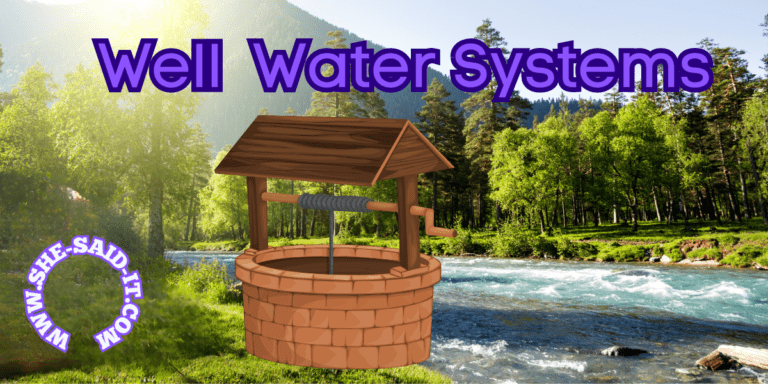Dewinterize Your RV – From Storage to Spring!

I have two RVs, a Class A that I keep as stationary as possible, and a Class B that I work out of. Each unit has a different level of winterization done to it every year. Anyone out there who stores their RV for winter needs to take care to dewinterize it properly and thoroughly. I think we are almost done winter here on Vancovuer Island BC, Canada. I’m preparing to dewinterize by Camper Van. It’s important to wait to dewinterize your water systems untill you are sure winter has passed. All it takes is one cold night to really mess up your plumbing! I’m living proof that you can camp in a winterized camper though(check out our related post about repelling rodents).
Introduction: Why Dewinterizing Your RV is Important
The winter months can be harsh on an RV, especially if it’s stored in a cold climate. During winter storage, your RV’s water system is typically drained and filled with antifreeze to prevent the pipes from freezing and bursting. However, once the winter is over and you’re ready to start using your RV again, it’s important to properly dewinterize it.
Dewinterizing your RV involves flushing out the antifreeze from your water system and preparing your RV for the upcoming camping season. This process ensures that your RV’s water system is safe to use, your propane tanks are filled, and your electrical system is working correctly. Additionally, it allows you to check for any damage that may have occurred during the winter months, such as cracked pipes or leaks.
It’s important to read your owners manual for your specific RV winterizing and dewinterizing is a little bit different for every rig.
If you fail to properly dewinterize the RV, you run the risk of damaging your water system, which can be costly to repair. You may also risk contaminating your water supply, which can be a health hazard for you and your family.
By dewinterizing your RV before the camping season begins, you can ensure that your RV is in good working condition and ready for your next adventure.
Steps: How to Dewinterize Your Camper: A Complete Guide
- Preparing Your RV for Dewinterizing: Before you start dewinterizing your RV, there are a few things you should do first. Make sure your RV is parked in a level area and disconnect it from any external power or water sources. Also, ensure that your RV’s water heater is turned off and that your propane tanks are turned off.
- Flushing the Antifreeze from Your RV’s Water System: The first step in dewinterizing your RV is to flush out the antifreeze that was used to protect your water system during the winter. Start by draining the antifreeze from your RV’s holding tank, then flush each water line until you no longer see any pink fluid.
- Sanitizing Your RV’s Water System: Once you’ve flushed out the antifreeze, you’ll need to sanitize your water system. Mix a solution of water and RV-safe sanitizing solution, then run the solution through your RV’s water system. Let the solution sit for several hours, then flush it out with clean water.
- Checking Your RV’s Batteries and Electrical System: Check the batteries in your RV and make sure they’re fully charged. Check your RV’s electrical system, including your lights and appliances, to ensure everything is working properly.
- Checking and Refilling Your RV’s Propane Tanks: Check your RV’s propane tanks and make sure they’re filled. You may also want to check the connections and hoses to ensure there are no leaks.
- Inspecting Your RV’s Tires and Brakes: Check the tires on your RV for any signs of wear or damage. Check the tire pressure and inflate them to the recommended level. Inspect your brakes to ensure they’re in good working order.
- Cleaning Your RV’s Interior and Exterior After Winter Storage: After sitting in storage all winter, your RV may need a good cleaning. Clean the interior of your RV, including the floors, walls, and appliances. Clean the exterior of your RV, including the roof, windows, and siding.
Step 1: Flushing the Antifreeze from Your RV’s Water System
When winterizing your RV, you likely added antifreeze to the water system to protect it from freezing temperatures. Now, it’s time to flush out that antifreeze so you can use your water system again.
- Drain the Antifreeze: The first step in flushing the antifreeze from your RV’s water system is to drain the antifreeze from your holding tank. This is usually located under the RV and can be drained using a valve or by removing the cap. Please note this will likely drain right onto the ground. You may want to place a bucket or tote underneath to avoid ground contamination. most RV antifreeze is non-toxic though.
- Connect to City Water: Once you’ve drained the antifreeze, connect your RV to a city water source using a potable water hose. Make sure the water pressure is low, so you don’t damage your RV’s water system. A water pressure regulator is always a good idea.
- Flush the Water Lines: Begin by flushing the cold water lines in your RV. Turn on each faucet and run the water until you no longer see any pink fluid. Repeat this process for the hot water lines, including the shower and toilet. If you are connected to septic drainage you should open the grey tank when you turn on all your faucets while connected to city water. Turn off all the faucets, be aware that your bathroom sink and shower may have been draining into the black water tank, feel free to empty that as well.
- Flush the Water Heater: To flush the water heater, turn off the bypass valve and turn on the water heater. Allow it to fill with water and run until the water is clear. Then, turn off the water heater and drain the tank.
- Rinse the Holding Tank: Once you’ve flushed out the water lines and water heater, it’s a good idea to rinse out the holding tank to remove any remaining antifreeze. Fill the tank with water and drain it several times until the water runs clear. It’s a good idea to do a thourough rinse of the black and the grey tank. If you are new to your rv, some have more than one grey tank.
- Check for Leaks: Finally, check your RV’s water system for leaks, if you need to stop your leaking toilet valve, check out this post on how to do just that. Turn off the city water and turn on the water pump. Run each faucet and check for any leaks. If you find a leak, tighten any loose connections or replace any damaged parts.
Step 2: Sanitizing Your RV’s Water System
After flushing out the antifreeze from your RV’s water system, it’s important to sanitize it to ensure that the water is safe for consumption.
- Drain the Holding Tank: Start by draining the holding tank completely. This will remove any leftover water from the flushing process.
- Mix the Sanitizing Solution: Prepare a sanitizing solution using a quarter cup of household bleach for every 15 gallons of water your RV’s fresh water tank holds. Mix the solution in a bucket and pour it into the fresh water tank.
- Fill the Fresh Water Tank: Fill the fresh water tank with potable water. Use a potable water hose to ensure that the water is safe for consumption.
- Run the Water: Turn on the water pump and run water through each faucet until you smell the bleach solution. This indicates that the solution has reached all parts of the water system.
- Let the Solution Sit: Once you’ve run the solution through the water system, let it sit for at least 12 hours. This will allow the bleach solution to kill any bacteria or viruses in the water system.
- Drain the Water: After 12 hours, drain the water from the fresh water tank and run water through each faucet until you no longer smell bleach. This will ensure that all traces of the sanitizing solution are removed from the water system.
- Refill the Fresh Water Tank: Finally, refill the fresh water tank with potable water and test the water for any remaining traces of bleach. If you detect any bleach odor or taste, repeat the flushing process until the water is completely clean.
It’s important that the bleach not sit in your RV system for more than 12 hours.
Checking Your RV’s Batteries and Electrical Systems
- Check the Battery Charge: Start by checking the charge level of your RV’s battery. If your RV has been in storage for an extended period, the battery may have lost its charge. Use a battery tester or multimeter to check the voltage of the battery. If the battery charge is low, recharge it before testing the electrical system.
- Inspect the Battery: Inspect the battery for any signs of damage, corrosion, or leaks. Check the battery terminals and connectors for any corrosion or loose connections. If you find any damage or corrosion, clean the terminals and connectors with a wire brush and replace any damaged parts.
- Check the Electrical System: Turn on the RV’s electrical system and check all lights, appliances, and electrical outlets to ensure they are working properly. Make sure that the circuit breakers and fuses are properly installed and not damaged.
- Test the Alternator: If your RV has an alternator, test it to ensure that it’s charging the battery properly. Use a multimeter to check the voltage output of the alternator. If the voltage is low, the alternator may need to be replaced.
- Check the Inverter: If your RV has an inverter, check it to ensure that it’s working properly. Turn on the inverter and check that all outlets and appliances powered by it are working properly. You want to check this when you are not plugged in to shore power.
- Test the Converter: If your RV has a converter, test it to ensure that it’s charging the battery properly. Turn off all electrical devices and measure the voltage at the battery terminals. Then turn on some electrical devices and measure the voltage again. The voltage should be higher when the devices are on, indicating that the converter is working properly.
Spring Maintenance on Motorhomes
Spring is a great time to perform routine maintenance on your motorhome to ensure that it’s in top condition for the upcoming travel season. Here are some important spring maintenance tasks to consider:
- Inspect the Roof: Inspect the roof of your motorhome for any cracks, tears, or other damage that may have occurred during the winter. Make sure to also check the seals around vents, antennas, and other protrusions on the roof.
- Check the Tires: Check the tires for proper inflation and any signs of wear, including cracks or bulges in the sidewalls. Replace any tires that are worn or damaged.
- Test the Batteries: Test the batteries to ensure they’re holding a charge and are in good condition. Replace any batteries that are worn out or damaged.
- Change the Oil and Filters: Change the oil and oil filter in your motorhome’s engine. Also, change the fuel filter and air filter if needed.
- Check the Brakes: Check the brake pads, rotors, and calipers for any wear or damage. Replace any parts that are worn or damaged, and have the brake system checked by a professional if you’re not confident in your ability to inspect it.
- Inspect the Electrical System: Check the electrical system, including the battery terminals, wiring, and fuses. Make sure all lights, appliances, and electrical outlets are working properly.
- Check the Plumbing System: Inspect the plumbing system, including all pipes, valves, and connections. Look for any leaks, cracks, or other damage. Turn on the water pump and check for any water leaks or drips.
- Check the Propane System: If your motorhome has a propane system, inspect it for any leaks or damage. Make sure that the propane tanks are properly secured and that all connections are tight.
- Check the HVAC System: If your motorhome has an HVAC system, inspect it for any damage or wear. Make sure that the air conditioning and heating systems are working properly.
- Clean and Lubricate: Clean your motorhome inside and out, and lubricate any moving parts, such as hinges and locks.
By performing these spring maintenance tasks on your motorhome every year, you can help ensure that your RV is safe and ready for your next adventure. It’s always a good idea to consult your owner’s manual or a professional mechanic for guidance if you’re not sure how to perform any of these tasks yourself.
Checking and Refilling Your RV’s Propane Tanks
It’s important to be aware that propane tanks should be certified according to your local laws and guidelines.
- Turn off All Propane Appliances: Before you start checking or refilling your propane tanks, turn off all propane appliances, including the stove, refrigerator, and water heater.
- Check the Tank Levels: Check the propane tank levels by looking at the gauge on the tank or by using a propane tank level indicator. If the tank is empty or low, you’ll need to refill it.
- Shut Off the Propane Supply: Shut off the propane supply valve on the tank before removing the tank from your RV. This will prevent any propane from escaping during the refill process.
- Remove the Empty Tank: Remove the empty propane tank from your RV and take it to a propane filling station. Make sure the tank is secure in your vehicle during transport.
- Refill the Tank: At the propane filling station, tell the attendant how much propane you need and hand over the empty tank. The attendant will refill the tank and return it to you.
- Reinstall the Refilled Tank: Once you have the refilled tank, reinstall it in your RV and turn the propane supply valve back on. Test your propane appliances to make sure they’re working properly.
- Check for Leaks: Check for any propane leaks by using a propane leak detector or by applying a solution of water and dish soap to all propane connections. If bubbles form, you have a leak that needs to be fixed before using the propane system.
- Make sure you have a propane alarm inside your RV, it’s important that you have more than one if your RV is large. It’s important to install these properly and to check them regularly.
It’s important to regularly check and refill your RV’s propane tanks to ensure that you have enough fuel for your travels. Make sure to only refill your propane tanks at a propane filling station and never attempt to refill them yourself. Always follow safety procedures when handling propane and consult a professional if you’re not comfortable with the process.
Inspecting Your RV’s Tires and Brakes
Inspecting your RV’s tires and brakes is an important part of RV maintenance that can help keep you safe on the road. This should be done every time you take your RV on the road. If you don’t feel comfortable with this process it’s important to learn either from Youtube or a licensed mechanic. Here are the steps to follow:
- Check the tires for signs of wear and damage, including cracks, bulges, and cuts. Look for uneven wear, which can be a sign of alignment or suspension problems. Check the tire pressure with a tire pressure gauge and make sure it is at the recommended level.
- Inspect the brake pads and shoes for wear. Look for any signs of damage or uneven wear. If the brake pads or shoes are worn down, they should be replaced.
- Check the brake rotors and drums for wear and damage. Look for any signs of scoring or grooves. If the rotors or drums are worn or damaged, they should be replaced.
- Inspect the brake lines and hoses for cracks, leaks, or other damage. Make sure the brake fluid level is at the recommended level.
- Check the wheel bearings for play or looseness. If the bearings are loose or worn, they should be replaced.
- Check the suspension components, including the shocks and struts, for wear or damage.
- Finally, take your RV for a test drive to make sure the brakes are working properly and the tires are balanced and aligned.
Cleaning Your RV’s Interior and Exterior After Winter Storage
Cleaning the Exterior:
When you dewinterize your RV there are many people who will advise you against using any kind of pressure washer on your RV. The pressure is very hard on the seals.
- Start by giving the RV a thorough wash with a mild detergent and a soft-bristled brush or sponge. Rinse it off with a hose, making sure to remove all soap residue.
- Inspect the RV’s exterior for any signs of damage or wear, such as cracks, dents, or rust. Address any issues as needed.
- Clean the windows with a glass cleaner and a microfiber cloth.
- Apply a protective wax or sealant to the exterior to help protect it from the elements.
Cleaning the Interior:
- Remove any items that may have accumulated inside the RV during storage.
- Vacuum the carpets, floors, and upholstery to remove any dirt, dust, or debris.
- Clean the countertops, cabinets, and other surfaces with a mild cleaner and a soft cloth.
- Clean the bathroom, including the shower, toilet, and sink, with a mild cleaner.
- Clean the kitchen, including the appliances, with a mild cleaner.
- Open the windows and vents to air out the RV.
- Replace any air filters or other items that may need to be changed.
Conclusion: Peace of Mind After You Dewinterize Your Rig
When you dewinterize your RV it’s important to follow the steps before hitting the road after a long winter of storage. By following the steps outlined in this post, you can help ensure that your RV’s plumbing, appliances, and other systems are in good working order and ready for use. Taking the time to properly de-winterize your RV can help you avoid costly repairs and ensure that your next adventure on the road is a safe and enjoyable one. So don’t hesitate to get started on dewinterizing your RV, and happy travels!
Shopping List
Here’s a list of the commonly used items for setting up your rig for the first time or for the season. Please note I have some great discount codes for camping world and many other RV speciatly items. If you click on any links on this site I may receive a small affiliate percentage that is the only way this site is paid for. I appreciate your patronage! Keep on Camping friends. Dewinterize your rv properly every season.
- Freshwater Hose: A hose that is specifically designed for drinking water is essential for filling up your RV’s freshwater tank and flushing the plumbing system.
- Water Pressure Regulator: A water pressure regulator will help protect your RV’s plumbing system from damage caused by high water pressure at campsites.
- Tire pressure gauge: Wether in a Motorhome or a trailer, your tire health is very important!
- RV Holding Tank Sanitizer: You will need RV sanitizer or bleach. It’s important to rinse very well after using any product of any kind in your rv freshwater tank.
- Disposable Gloves: Disposable gloves are a must-have for handling antifreeze and other chemicals during the dewinterization process.
- Water Filter: A water filter can help improve the quality of the water in your RV’s freshwater tank and protect your plumbing system from sediment and other contaminants.
- Cleaning Supplies: You will need cleaning supplies such as a mild cleaner, soft-bristled brush or sponge, and microfiber cloths to clean the RV’s interior and exterior after winter storage.
- Lubricant: A lubricant, such as silicone spray, can help protect and lubricate the RV’s slide-out seals, hinges, and other moving parts.
- Propane: If you plan to use propane appliances, such as the stove or furnace, you will need to fill up the propane tank.
- Batteries: Make sure your RV’s batteries are fully charged and in good working order. It’s important to have a voltmeter onhand.
Quick Amazon Links:











here are a couple of links to my other blog posts that you might find interesting.
What’s the best water filter system for your RV?







